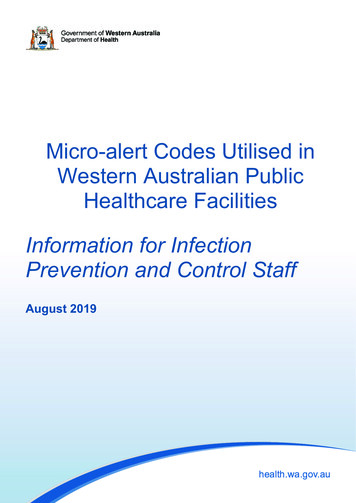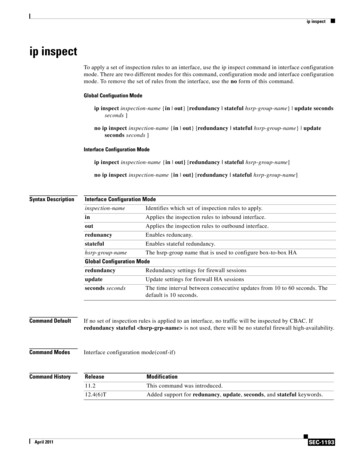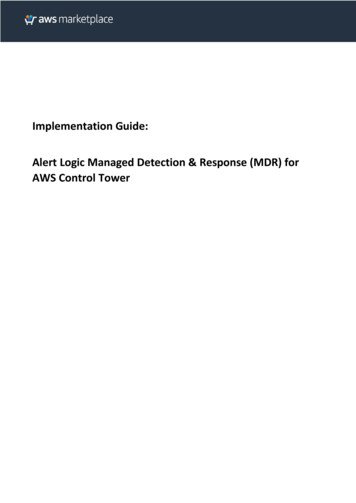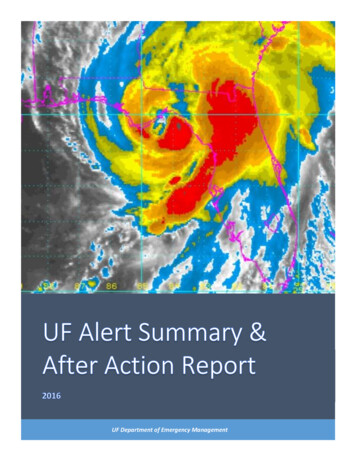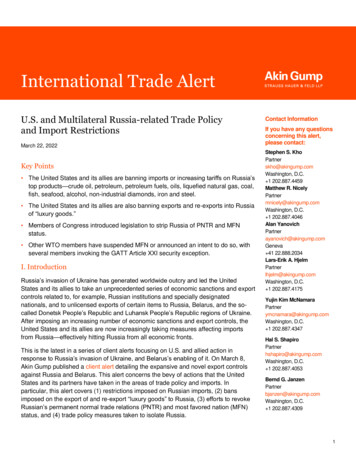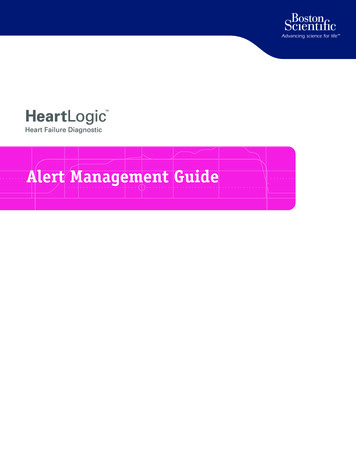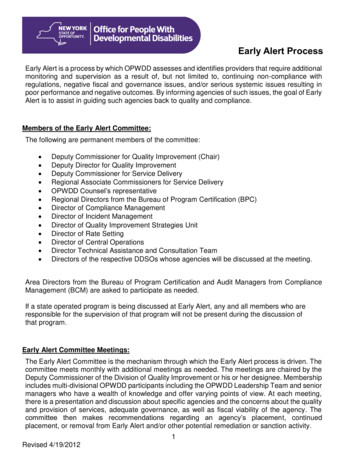
Transcription
Early Alert ProcessEarly Alert is a process by which OPWDD assesses and identifies providers that require additionalmonitoring and supervision as a result of, but not limited to, continuing non-compliance withregulations, negative fiscal and governance issues, and/or serious systemic issues resulting inpoor performance and negative outcomes. By informing agencies of such issues, the goal of EarlyAlert is to assist in guiding such agencies back to quality and compliance.Members of the Early Alert Committee:The following are permanent members of the committee: Deputy Commissioner for Quality Improvement (Chair)Deputy Director for Quality ImprovementDeputy Commissioner for Service DeliveryRegional Associate Commissioners for Service DeliveryOPWDD Counsel’s representativeRegional Directors from the Bureau of Program Certification (BPC)Director of Compliance ManagementDirector of Incident ManagementDirector of Quality Improvement Strategies UnitDirector of Rate SettingDirector of Central OperationsDirector Technical Assistance and Consultation TeamDirectors of the respective DDSOs whose agencies will be discussed at the meeting.Area Directors from the Bureau of Program Certification and Audit Managers from ComplianceManagement (BCM) are asked to participate as needed.If a state operated program is being discussed at Early Alert, any and all members who areresponsible for the supervision of that program will not be present during the discussion ofthat program.Early Alert Committee Meetings:The Early Alert Committee is the mechanism through which the Early Alert process is driven. Thecommittee meets monthly with additional meetings as needed. The meetings are chaired by theDeputy Commissioner of the Division of Quality Improvement or his or her designee. Membershipincludes multi-divisional OPWDD participants including the OPWDD Leadership Team and seniormanagers who have a wealth of knowledge and offer varying points of view. At each meeting,there is a presentation and discussion about specific agencies and the concerns about the qualityand provision of services, adequate governance, as well as fiscal viability of the agency. Thecommittee then makes recommendations regarding an agency’s placement, continuedplacement, or removal from Early Alert and/or other potential remediation or sanction activity.1Revised 4/19/2012
Early Alert Trigger PointsThe following are some common examples that could lead to an agency being presented fordiscussion at an Early Alert Committee meeting, and which may result in the agency being placedon Early Alert. The following issues may not all present a serious concern in isolation, however inaggregate, or in close sequence, may indicate systemic deficiencies.1. Program Deficiencies: A failure to report, investigate or provide needed individual protections in situations thatwarrant reporting as allegations of abuse or neglect Deficiency trends based upon OPWDD analysis. For example:o Substantiated allegations of abuse, neglect, significant injuries of unknownorigin or unexpected deaths among program participantso Repeated and/or significant lack of regulatory compliance resulting in 45 or60 day letters, especially in the areas related to individual health and safetyo Repeated failure to develop and/or implement acceptable Plans of CorrectiveAction, especially in the areas related to individual health and safetyo Systemic ongoing deficiencies in critical operational areas such as nursing,health care, medication administration, incident reporting, fire safety, etc.o Chronic staffing issues including high staff turnover, frequent use oftemporary or per diem staff, failure to replace needed clinical staff in a timelymannero Patterns of significant complaints2. Fiscal Deficiencies: Receipt of Medicaid payment suspension letter from the Medicaid Fraud Control Unit(MFCU) of the Attorney General’s office Poor financial position as represented by key ratios, (Current ratio, Quick ratio, DaysCash) and significant negative working capital resulting in foreseeable fiscal crisis Inability to meet payroll or pay payroll tax withholdings Incidents of bounced checks, especially payroll checks Tax delinquencies resulting in receipt of notice of liens Outstanding liabilities as the result of an audit Chronic failure to submit fiscal reports such as Consolidated Fiscal Report andfinancial statements Diversion of funds to other entities Loan of agency funds to members of the Board of Directors (BOD), agencyemployees or other entities Serious lapse of fiscal record keeping resulting in OPWDD’s inability to measure theAgency’s fiscal condition Breakdown of internal controls as identified by a review or audit, leading to misuse ofagency funds2
3. Governance Deficiencies: There is no evidence of regular board meetings in accordance with the agency’s ByLaws There is no evidence (written minutes of the BOD meetings) to indicate that issues suchas incidents, health and safety violations, major physical plant issues, the Agency’sbudget and any fiscal concerns are discussed routinely at board meetings No evidence of BOD discussion of audit findings from external agencies BOD lack of oversight of agency personnel including Executive staff Lack of awareness on the part of the BOD regarding the fiscal or programmatic issuesfacing the agency Lack of BOD participation in the policy setting activities of the agency Lack of independence and objectivity between the BOD and the Executive Director,leading to poor decisions/actions by the Executive Director and the Executive Directornot being held responsible for the outcomes Conflicts of interest between BOD members and the agency and /or Executive DirectorEarly Alert NotificationThe Deputy Commissioner of Quality Improvement will provide written notification to the Agency’sBoard of Directors (Board of Visitors for State Operated Facilities) and Executive Director that theagency has been placed on Early Alert. The notice will include the rationale for OPWDD’sdecision. A subsequent meeting will be conducted with agency Executive staff, the BOD (orgoverning body), and representation from the Division of Quality Improvement to discuss thespecific concerns identified, OPWDD’s monitoring process and any further requested actions.Early Alert does not affect the certification or funding of an agency or its current programs.However, while an agency is on Early Alert, OPWDD will not consider any requests for expansionof services. The list of agencies on Early Alert will be posted on the OPWDD’s website.Potential Course of Action by the Early Alert Committee:1. MonitoringThe Early Alert committee will conduct enhanced monitoring of an agency on Early Alertfor a period of time to be determined by OPWDD. The agency’s development and implementation of a management plan, withmeasurable benchmarks, that has been reviewed and approved by OPWDD staff, toaddress governance, fiscal and/or programmatic issues. OPWDD may require theagency BOD to report to OPWDD regularly on the implementation of the plan. As a rule of thumb, a demonstration of sustained compliance will take six monthsfrom the time an agency begins to implement corrective actions. In addition to correcting deficiencies and problems that have been discussed with theagency as part of the Early Alert process, the agency must be able to demonstratesustained compliance.OPWDD will consider additional remedial and/or adverse actions at any time.3
2. Remedial ActionsRemedial actions may be recommended by the Early Alert committee based on a varietyof factors including the size of the agency, the nature and extent of the problems identifiedand the agency’s history as an OPWDD provider. Such actions may include: Prescribing a directed Plan of Corrective Action and requiring the agency to engage incertain prescribed remedial activities such as hiring a QA consultant. . Requiring training of the Board of Directors Requiring technical assistance from an entity approved by OPWDD Early AlertCommittee. OPWDD review of the agency’s accounts receivable to determine if the agency ismaximizing cash flow3. Adverse ActionsNotwithstanding steps to enhance monitoring and promote remedial actions, the Early Alertcommittee may recommend adverse actions in response to an agency’s failure to complywith program requirements. These actions may include: Recommendations to fine providers as stipulated in the 6/1/11 Financial AccountabilityInitiative memo from the OPWDD Acting Executive Deputy Commissioner. Fines arebased upon circumstances encountered during survey and certification activities orreview of agency incident management that are of such a significant nature or severityrelated to health and safety that the implementation of a fine is warranted. Change of Auspice Surrender, limitation, termination or nonrenewal of, operating certificates of one ormore sites, surrendering, limitation of, or termination of, the Agency’s provideragreement or cancellation of OPWDD contracts. During this time the agency’sprograms will be monitored by OPWDD staff including DQI/BPC and DDSO staff. Thismay require an agency to submit closure plans in accordance with OPWDD regulationsand continue to implement plans of corrective action.Removal of an Agency from Early Alert StatusAn agency that has been placed on Early Alert will be removed from the list when it: Demonstrates that both site specific and systemic issues of concern have beencorrected, and corrections have been sustained4Revised 4/19/2012
Has implemented processes to prevent recurrenceTransitions service(s) to another agency, and/orNo longer provides OPWDD services5
Early Alert does not affect the certification or funding of an agency or its current programs. However, while an agency is on Early Alert, OPWDD will not consider any requests for expansion of services. The list of agencies on Early Alert will be posted on the OPWDD's website. Potential Course of Action by the Early Alert Committee: 1. Monitoring

